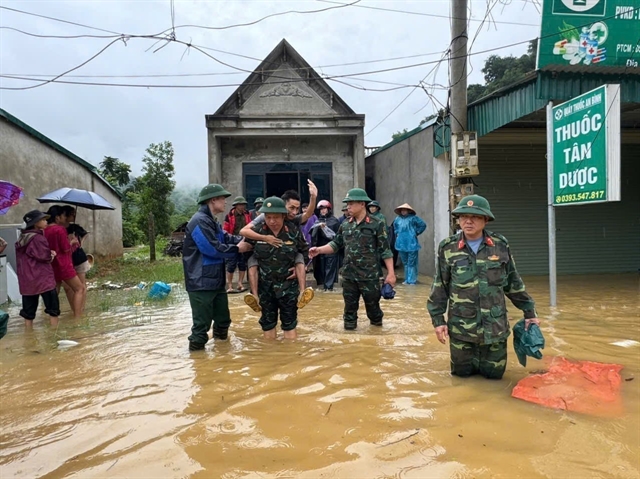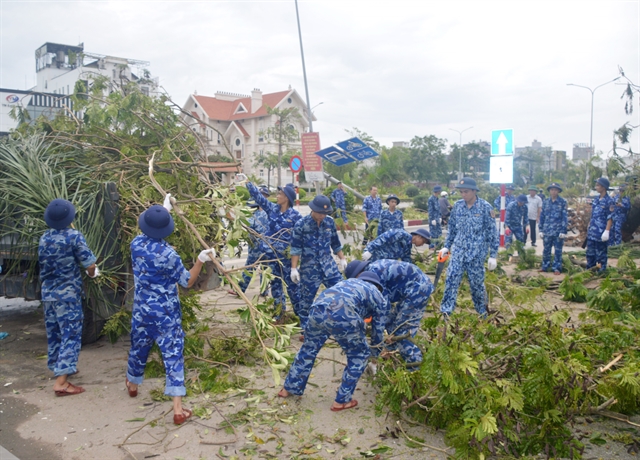 |
| Trần Đức Thắng (third from left), chairman of Quảng Yên Town People's Committee, Quảng Ninh Province, checking preparations for super typhoon Yagi at a construction site. — VNA/VNS Photos |
HÀ NỘI — In the early hours of September 7, as the city slept, lights were on in a room on the 12th floor of the General Department of Meteorology and Hydrology headquarters.
Known as the room that never goes dark, it is the nerve centre of Việt Nam’s storm monitoring operations, where forecasters grappled with the immense challenge posed by Super Typhoon Yagi.
This super typhoon, the strongest to strike Việt Nam in three decades, left meteorologists, officials and storm trackers without rest as they faced the task of predicting its every move.
Living with the storm
Mai Văn Khiêm, director of the National Centre for Hydro-Meteorological Forecasting, worked through the night on September 6.
At his post, he guided his team, analysing the storm's trajectory as Yagi moved closer to Việt Nam’s coastline.
In a rare moment of rest, Khiêm said that forecasting efforts for the massive storm had started early.
The entire political system was drawn into the effort to predict and monitor this huge storm. From the Prime Minister to the National Civil Defence Steering Committee, all eyes were on the forecasts.
Forty-eight hours before the typhoon struck Hainan Island in China, both international and Vietnamese forecasting agencies had agreed that Yagi would not weaken significantly as it moved into the Gulf of Tonkin and towards Việt Nam's coast.
Predictions held that winds would remain at level 13-14, and the typhoon would likely hit Việt Nam's coast with a strength of level 12 or higher.
Despite the tight timelines and evolving data, Vietnamese meteorologists' predictions matched those of Japan, South Korea, China and other international forecasting agencies.
The collaboration didn’t stop there.
Khiêm’s team exchanged data and insights with Japan’s Regional Typhoon Centre and China's Meteorological Bureau, ensuring that nothing was left to chance.
As the typhoon closed in, the pressure mounted. Hourly bulletins went out, as well as urgent updates every three hours.
Information about risks like heavy rainfall, flash floods and landslides was shared widely.
Every 10 minutes, updated satellite images, radar readings and on-the-ground reports from coastal monitoring stations were analysed.
"Even the smallest changes could spell disaster. We had to monitor everything," he told Vietnam News Agency.
For days, the team lived and breathed the typhoon, tracking its path as it maintained its brutal intensity over the East Sea (internationally known as South China Sea). It didn’t lose power as expected, even after landfall on Hainan, and maintained super typhoon strength as it bore down on Việt Nam.
By the time the storm’s last report was filed on September 8, the centre had released 46 official reports and 63 rapid updates.
They had navigated the storm with meticulous precision, their tireless efforts had been playing a crucial role in mitigating its effects.
 |
| Officers and soldiers of the Military Command of Hàm Yên District in Tuyên Quang Province help evacuate people to safe places. |
Unyielding force
While typical storms tend to lose power after crossing Hainan Island, this one defied expectations. It hit Quảng Ninh and Hải Phòng with ferocity, lingering over land for 12 hours and creating havoc in its wake.
As the storm passed, a sense of relief swept through the team. “We’re glad it’s weakened,” Khiêm said, though his concern remained, especially as the typhoon's aftermath still threatened with heavy rainfall and flash floods.
While Khiêm and his team laboured over weather maps and radar screens, Deputy Prime Minister Trần Hồng Hà was on the ground in Hải Phòng with a government task force, overseeing final preparations as the storm loomed large.
Coastal provinces under threat were in lockdown, namely Quảng Ninh, Hải Phòng and Thái Bình. Maritime activities were banned and residents had been advised to shelter in place. Airports across the northern regions, from Vân Đồn in Quảng Ninh to Nội Bài in Hà Nội, suspended flights as the storm raged.
The People’s Army of Việt Nam was also on standby.
Nearly 458,000 soldiers, over 10,000 vehicles and even helicopters had been mobilised to respond to the typhoon. Over 100,000 police officers were similarly deployed, prepared to assist with flood and storm response efforts across 35 provinces.
In Cô Tô District, Quảng Ninh Province, a strict curfew was enforced. In Hải Phòng, industrial zones and ports were fortified against the oncoming storm.
Across the northern provinces of Nam Định, Thái Bình and Ninh Bình, north central province of Thanh Hóa, heightened preparations for storm continued.
Hà Nội was no different.
The city's Party Secretary Bùi Thị Minh Hoài ordered immediate, city-wide storm response efforts, ensuring the capital’s residents were safe as Yagi approached.
All efforts were aimed at ensuring the safety of residents.
For a country like Việt Nam, with over 3,260km of coastline and dozens of typhoons and tropical storms annually, experience in dealing with such weather events is abundant.
However, Yagi has imparted crucial lessons on the need for coordinated responses from the entire political system, heightened vigilance towards natural disasters and the unified effort of the populace in strictly adhering to official advisories and regulations.
Even before Typhoon Yagi reached the eastern Philippines, Prime Minister Phạm Minh Chính issued urgent directives, underscoring the importance of early, proactive and decisive measures to minimise damage.
Deputy Prime Minister Trần Hồng Hà was assigned to directly oversee the response efforts, establishing a forward command post at Military Region 3 in Hải Phòng City to coordinate with local authorities.
The Minister of Agriculture and Rural Development also issued directives from September 2 and managed remote response operations.
Before the storm made landfall, two inspection teams led by the Deputy Prime Minister and the Minister of Agriculture and Rural Development conducted assessments and provided guidance across coastal provinces from Quảng Ninh to Thái Bình.
 |
| Coast guard forces clean up fallen trees after the storm in Hải Phòng City. |
Damage assessment and recovery efforts
As of 11am on September 11, the number of people killed or reported missing due to the storm has reached 292.
Hundreds of thousands of hectares of rice paddies, crops and orchards are underwater and severely damaged. Thousands of fish farming cages have either been destroyed or washed away.
Many stores, offices, homes and schools have lost their roofs or suffered significant damage, while numerous advertising billboards, telecommunication poles and mobile network towers have been toppled.
Trees have been uprooted and strewn across roads in Quảng Ninh, Hải Phòng, Hải Dương and Hà Nội.
On September 7, Deputy PM Hà directed provinces and cities to swiftly commence recovery efforts, focusing on stabilising residents' lives, restoring power and re-establishing communication systems.
The Ministry of Industry and Trade and the Ministry of Information and Communications were tasked with rapidly restoring essential services, while the Ministry of Defence and local forces managed clean-up and relief operations.
Prime Minister Phạm Minh Chính highlighted that despite serious response efforts, the damage is still considerable. The key lesson from Yagi underscores the importance of decisive leadership, coordinated actions and thorough preparation. Agencies and local authorities must continue to be prepared for emergency situations, ensuring the safety of citizens and swift recovery from disasters.
With the Government's timely and decisive leadership, coupled with societal solidarity and strict adherence to guidelines, Việt Nam has successfully navigated the challenges posed by Typhoon Yagi. Although the storm has left some individuals with enduring pain, it also serves as a significant lesson in unity and resolve in disaster response. — VNS


